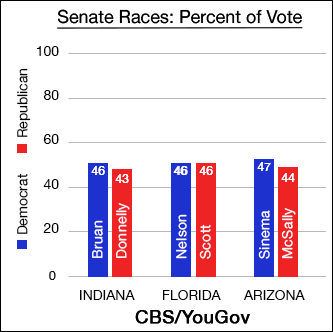By Jim Ellis
 Oct. 30, 2018 — CBS News/YouGov just published new numbers from three key Senate races, all conducted late last week during the Oct. 23-26 period, that largely confirm recent trends.
Oct. 30, 2018 — CBS News/YouGov just published new numbers from three key Senate races, all conducted late last week during the Oct. 23-26 period, that largely confirm recent trends.
The Indiana race has seemingly turned toward Republican challenger Mike Braun in recent days, and the CBS/YouGov poll confirms the new direction. According to their poll (975 likely voters, online), Braun holds a 46-43 percent lead over Sen. Joe Donnelly (D). This is wholly consistent with other polling conducted since Oct. 14.
As we reported last week, Mason Strategies (Oct. 15-20; 600 likely Indiana voters) finds Braun up by an almost identical 47-43 percent margin, while American Viewpoint in polling for the Braun campaign (Oct. 14-17; 800 likely Indiana voters) sees a 44-40 percent spread.
CBS/YouGov then surveyed, as so many others have done recently, the Florida Senate race. After Sen. Bill Nelson (D) went ahead beyond the margin of error over Gov. Rick Scott (R) in a pair of polls, two more studies turned in the latter man’s favor. Then, St. Leo University (Oct. 16-22; 698 likely Florida voters), Strategic Research Associates (Oct. 16-23; 800 likely Florida voters), and Gravis Marketing (Oct. 22-23; 773 likely Florida voters) all saw Sen. Nelson rebounding with an advantage of nine, one, and four points, respectively.
But, CBS/YouGov finds the race returning to parity. Their results, from a pool of 991 randomly selected and weighted online respondents, peg the race as a flat tie, at 46 percent apiece.
The national media/polling partnership also tested the tight Arizona Senate race. Here, CBS/YouGov (972 likely voters) finds US Rep. Kyrsten Sinema (D-Phoenix) re-claiming an edge over Rep. Martha McSally (R-Tucson) by a 47-44 percent clip.
In five previous October polls, each candidate was staked to a small lead in two instances, while one survey, from Change Research for Democratic gubernatorial candidate David Garcia (Oct. 9-10; 783 likely Arizona voters), saw both Sinema and McSally pulling 44 percent support. The new CBS/YouGov Oct. 23-26 result of 47-44 percent (Sinema) produced an identical result to their Oct. 1-2 survey (600 likely Arizona voters).
What the CBS News/YouGov series confirms is that all of these races continue to languish within the polling margin of error as we approach the election cycle’s final week.
Therefore, as we have known for some time, races like these are all turnout battles, and whichever party does a better job of bringing its voters to the polls will likely win each respective race.
Though the final days could be determinative regarding who wins each of these races, it will likely only be so for half of the electorate. In each of the three states studied here, early voting is running way ahead of the 2014 midterm pace, and it appears that about half of the projected turnout in each state may have already been achieved.
In Arizona, through Oct. 28, 854,048 ballots already have been submitted. Compare that to the total 2014 voter turnout of 1,537,671. This year, more than 2.5 million absentee/early ballots have been requested.
The Indiana early voting system is more restrictive than Arizona’s, however. Therefore, the total Hoosier State early vote is likely to be less than in many states. But early voting has already exceeded the 2014 pre-election total. Through Oct. 28, 292,726 ballots already have been cast; in 2014, the total was 228,932. The entire Indiana 2014 turnout was 1,387,622 voters.
Florida is one of the more prolific early voting states. In 2014, just over half of all ballots were sent in before Election Day. Through Oct. 28 this year, 2,558,850 ballots have been received. In 2014, 3,187,342 people voted early. The early voting period runs through Saturday, Nov. 3.
All early voting statistics quoted came from the United States Elections Project.
